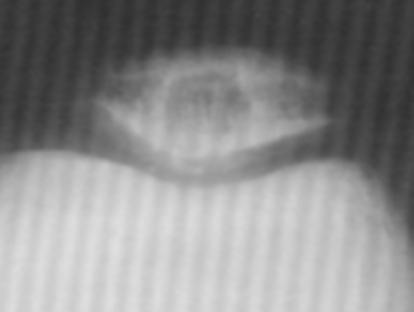|
Demni
K*,
Afifi A*,Atarraf K*, hater L*, Arroud M*, Rami M*,
Bouabdallah Y*
*
Department of Pediatric Surgery,
University
Hospital
–
FES,
Morocco
Address for Correspondence:
Karim Demni
Appt 23, Imm. H, Résidence AL BAIDA
20100,
CASABLANCA
MORROCCO
E-mail: demnikarim@yahoo.com
Tel: (OO212) 62 01 42 75
|
|
Abstract:
A
case of tuberculosis of the patella presenting as an osteolytic
lesion without synovial involvement is described. Delay in
diagnosis resulted in progression to generalized tuberculous
synovitis. Clinicians should consider the possibility of a
diagnosis of tuberculous osteomyelitis of the patella in
patients presenting with an osteolytic patellar lesion in areas
where tuberculosis is pandemic or in immunocompromised patients
J.Orthopaedics 2007;4(3)e23
Keywords:
Osteolytic lesions, tuberculosis, patella, children
Introduction
:
Osteoarticular
tuberculosis is still prevalent in under-developed countries and
bizarre presentations may be encountered. In Western countries
migrant populations and immunocompromized patients have recently
lead to some resurgence of the disease, making tuberculosis, in
all it’s forms, an important part of the differential
diagnosis of cystic bone lesions.
Tuberculosis
causing an osteolytic lesion in the patella is extremely rare.
We describe such a case and discuss the various features, both
clinical and radiological, which may help in the diagnosis. A
review of the literature is presented along with a discussion of
the treatment.
Case Report:
A
14 years old boy, presented to us with the complaints of pain
and swelling in the left knee joint of 2 monthes duration. There
was no history of trauma to the knee, fever or any chest
symptoms. Clinical examination revealed no increase in local
temperature over the joint, effusion or synovial thickening.
Laboratory investigations showed a total leucocyte count of
7000/mm3 with mild lymphocytosis and an erythrocyte
sedimentation rate of 20 mm at the first hour. The Mantoux test
for tuberculous infection sensitivity gave an induration of 26
mm at 48 h. A radiograph of the chest was normal. Lateral and
face views of the knee joint showed an osteolytic lesion of the
patella with no involvement of the articular surface and no
image of sclerosis (Figure 1-2). Clinically and radiographically
a presumptive diagnosis of tuberculosis was made and the
possibility of benign bone tumour was considered. Excision of
the sequestrum was performed and the lesion was subjected to
histopathological examination. The pathologist reported it to be
a degenerative lesion with no features suggestive of neoplastic
origin.
An
arthorotomy was done with the aim of synovectomy and joint
debridement which yielded positive cultures for Mycobacterium
tuberculosis when grown in
Lowenstein-Jenson’s
medium. The patient was then started on antituberculous drugs
which yielded a definite symptomatic improvement.
Actually,
the patient has minimal pain, walking with full weight bearing
but has restriction of knee flexion to 60°.

Fig
1: Ostéolysis lesion of the patella

Fig 2: centrosomatic ostéolysis
Discussion :
Isolated
tuberculous involvement of the patella is extremely rare (1,6).
The importance of early and accurate diagnosis and the
imposition of appropriate therapy is underlined by the present
case; early institution of antituberculous drugs may have
minimized the spread of the disease inside the joint and may
have perhaps decreased the patient’s morbidity and given him a
better knee function. The recognition of this pathology is
important, both in our underdeveloped countries where this
disease is still prevalent, and in developed countries where a
resurgence of tuberculosis has recently been noticed in
immunocompromised patients. It is important that tuberculosis be
included in the differential diagnosis of all osteolytic lesions
of the patella, especially in developed countries.
From
an epidemiological point of view, the knee joint is the third
most common joint involved in tuberculosis in the body (4,6).
The patella however, as a
primary
site, is most uncommonly involved. In a review of 1074
osteoarticular tuberculous lesions Tuli(6), reported an
incidence of 90 cases (8.3%) involving the knee, only one
(0.09%) of which was localized in the patella. Martini and
Boudjema(4),have mentioned one case of tuberculous osteomyelitis
of the patella in 652 cases (0.15%). One case of the above two
did not involve the joint, while the other ultimately lead to
complete joint destruction due to treatment delay. Of 10 603
tuberculosis patients seen over a 46 year period in a hospital
mainly for skeletal tuberculosis, only two cases had cystic
tuberculosis of the patella (2)
In
spite of the rarity of this type of tuberculosis, a high index
of suspicion has to be maintained to achieve a good end result
especially in our countries.
Although
cystic lesions of the patella are rare, an increasing number of
cases are being reported in the orthopaedic literature (7,8).
Previous
authors have suggested that the absence of sclerosis and
location in a para-articular region should suggest tuberculosis
(5). However, a review of the literature has revealed only one
common denominator in radiographical findings; an osteolytic
lesion in the patella. Nevertheless, a sequestrum has been
reported in more than half of these cases, and this sequestrum
may be a diagnostic clue.
From
a treatment point of view, the basic treatment in the form of
early institution of adequate anti-tuberculous therapy and
guarded function can not be over emphasized. However, a tissue
or bacterial diagnosis is essential, and some form of biopsy
either excisional or incisional is required.
We
advocate that incision in the patella, adequate curettage and
biopsy, followed by the early institution of chemotherapy. Some
cases may show generalized involvement at initial presentation,
which makes the diagnosis easier, but with worse prognosis.
Reference :
-
Bonnet C, DeBandt M, Palazzo E, Malaizier, D.
Tuberculosis involving the patella. Am J Roentgen01 1992;
159: 677
-
Hartofilakidis-Garofalidis G. Cystic tuberculosis of the
patella. J Bone Joint Surg [Am] 1969; 51A: 582-5
-
Hernandez Gimenez M, Beltran JVT, Sequi MIF, Gomez
EP. Tuberculosis of the patella. Pediatr Radio1
1987;17: 328-9
-
Martini M, Boudjema A. Tuberculous osteomyelitis. In
Martini M, ed. Tuberculosis of the Bones and Joints.
Berlin: Springer Verlag, 1988, pp. 78-9
-
Shah P, Ramakantan R. Tuberculosis of tbe patella. BP.
J. Radiol. 1990; 63: 3634
-
Tub SM. Tuberculosis of the Skeletal System.
New Delhi
, India: Jay Pee Brothers Medical Publishers, 1991, pp.
3,78-9
-
Ehara S, Khurana JS, Kattapuram SV, Rosenberg AE,
El Khoury GY, Rosenthal DI. Osteolytic lesions of the
patella. Am J Roentgen01,1989; 153: 103-106
-
Sur RK, Singh DP, Dhillon MS, Gupta BD, Murali B, Sidhu R.
Patellar metastatis: a rare presentation. Br J
Radio1 1992; 65: 7224
|




